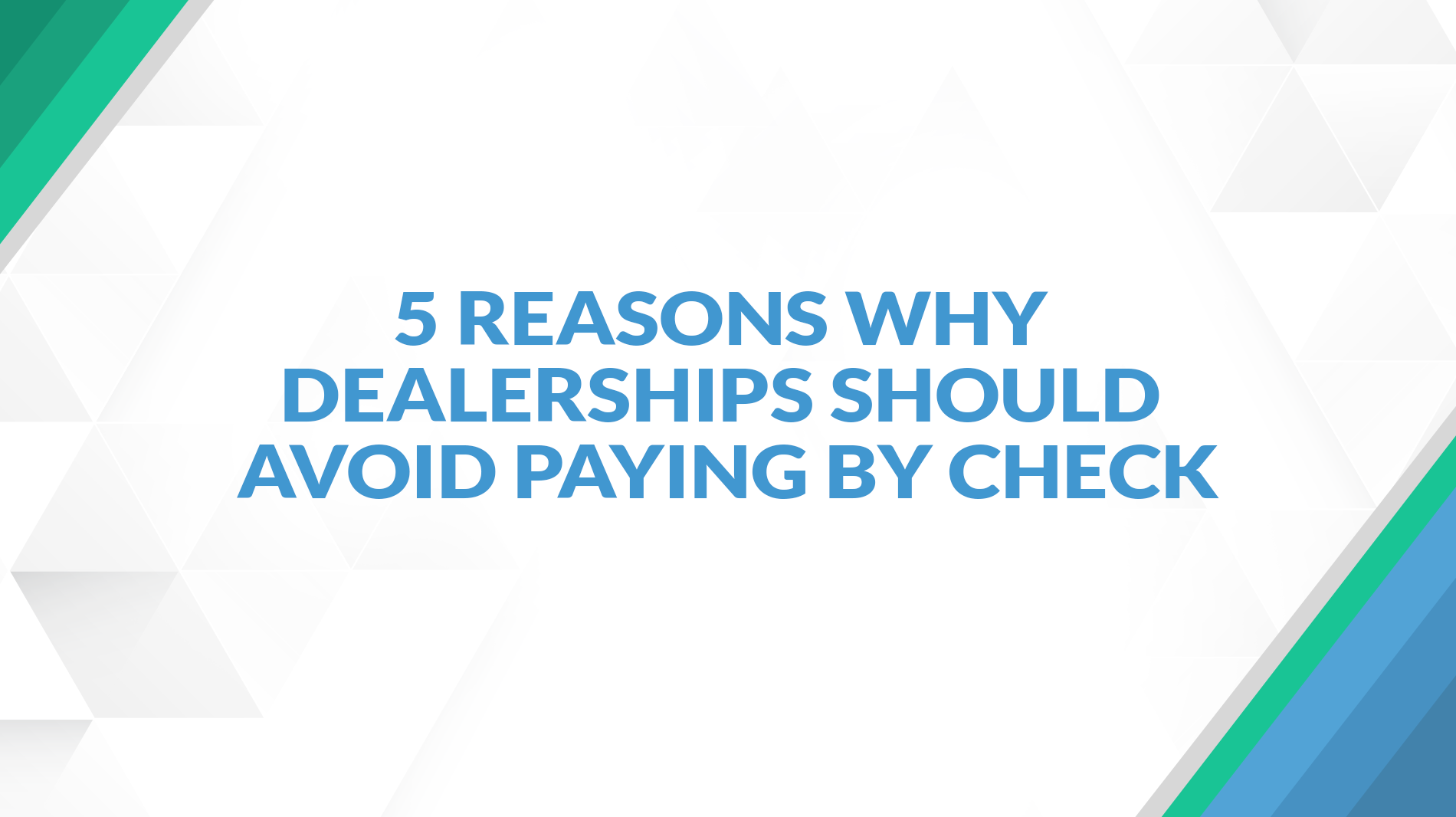Automated Accounts Receivable Programs: Cutting DSO by 30% in Six Months
In today’s economy, speed to cash is as important as speed to market. Companies that let receivables linger for 60, 75, or even 90 days are putting...

It’s time for your auto dealership’s AP department to go from Stone Age to the Digital Age with electronic payments! They’re cheaper and more secure than checks, plus your vendors will get paid faster.
In the Stone Age of accounts payable processing, vendors waited for checks (and waited for checks) while hurried accounting staff on the other side of the transactions rushed around doing manual tasks like matching POs with invoices, getting approvals, and stuffing paper checks into envelopes just before the afternoon mail pickup. Unfortunately, payments didn’t always make it on time, and businesses missed out on valuable cash rebates—not to mention—there were paper stacks the size of dinosaurs left roaming around employees’ desks.
Sound familiar? Or is your dealership past that era?
There’s nothing inherently “wrong” with paper checks, but processing paper checks these days is much more inefficient and costly than decades ago when there wasn’t any other way to pay vendors. Invoice processing (from presentment to posting) is difficult enough, let alone having to deal with all the steps and sign offs required with cutting checks. And keep in mind … when your accounting staff is stuck performing a myriad of manual functions, they’ve got less time for things like financial reporting, spend forecasting, and budget maintenance.
So how much does it cost to process a paper check? Statistics vary, but $3 to $6 per check is a commonly reported average, and that range doesn’t even consider the additional inputs involved, such as materials, postage, and employee salaries. Believe it or not, in 2016 the Bank of America was reporting that the overall cost of issuing a check ranged from $4 to $20 per transaction. Now that’s pricey!
Fortunately, many financial executives today plan to move away from paper checks soon. A 2022 Payments Cost Benchmarking Survey from the Association for Financial Professionals (AFP) found that 73% of organizations have plans to transition their B2B payments from checks to electronic payments over the next year. That’s great to hear because an estimated 40% of all B2B payments are still made by paper check. High processing costs are just one problem with paper checks, and are a few more:
When it comes to payment methods, some businesses continue relying on checks because, “It’s the way we’ve always done it.” Heard that one before? To expand on this point, checks are still universally accepted by most vendors, so switching payment methods would need to add value and make transactions simpler for businesses to consider changing the way they pay vendors.
It’s also important to note that some vendors do not accept electronic payments, so that leaves the burden on the business to continue paying via check or seeking out vendors who actually do accept electronic payments. However … sometimes the proposition alone of early payments or on-time payments is enough to incentivize a vendor to go digital.
With advances in payment technologies and increased interest in digital transformation, payment processing has evolved significantly over the past few decades. And although remittance by check still makes up a fair percentage of AP department payment activity, other methods are gaining popularity thanks to automation solutions. Here’s a little background on other payment options:
The beginnings of ACH transactions date back to the late 1960s when a group of California bankers became concerned about check volumes outpacing processing equipment and technology. The ACH network was then formed in the mid-1970s to facilitate quick and easy electronic funds transfers (EFTs). Administrated by Natcha, the ACH network is now used widely in banking for secure, encrypted credit and debit transactions.
Research has found that businesses are increasingly using ACHs to make payments, and in 2021, the transaction type experienced a 20.4% year-over-year growth rate. Transaction fees are fairly low, and according to an Association for Financial Professionals (AFP) report, the median cost of initiating and receiving an ACH payment ranges from 26 cents to 50 cents each.
Businesses began using corporate credit cards in the 1970s and despite average interchange fees of 1 to 3% per transaction, they can be a good way to make fast, secure payments to vendors as well as serve as an accurate method of tracking expenditures. By paying with credit cards, some industries can gather cash back on purchases plus receive discounts for early payments—which further incentivizes their use. Although PYMNTS reported in 2021 that under 50% of businesses pay by credit card, that number could change fast, and here’s why: virtual credit cards.
Virtual credit cards are a newer technology similar to corporate credit cards but without the physical format. Each card still has a 16-digit number sequence, expiration date, and CVV code and can be presented anywhere corporate cards are accepted. What makes them so unique is that they boast features unmatched by any other B2B payment type.
Virtual cards can be issued for single- or multiple-time use, be preset with limits to pay only certain suppliers, integrated with accounting automation software for easy processing and reconciliation, and much more. Virtual card transactions are expected to increase rapidly worldwide, from $1.9 trillion of activity in 2021 to $6.8 trillion in 2026, as reported by Juniper Research in 2021.
If you want to get away from cumbersome and costly check processing, it’s time to start thinking about how you can best incorporate electronic payments into your AP processes. Choosing a good dealership AP automation software like CloudX’s APSmart is a good start because once you implement this technology, you will eliminate a significant amount of manual workload and set the stage for faster payment processing.
Ideally, you want an automation software that includes an integrated payables solution, and APSmart works seamlessly with PAYSmart to help you pay vendors efficiently through a single platform. These software also work seamlessly with top DMS solutions including Dealertrack DMS, CDK Global, and Tekion (coming soon).
To convince you a little more, here are five reasons electronic payments are better than checks:
After discovering the many reasons electronic payments are better than paper checks, now is the time to digitally transform your accounting department with AP automation solutions like CloudX’s APSmart and PAYSmart!
Still uncertain whether your dealership needs an automation solution? Then answer the following questions:
If you’ve answered “yes” to any of these questions, your auto dealership should implement AP automation and electronic payment solutions to increase your volume of electronic payments and fast-track your accounting workflows. CloudX can review your goals, walk you through the implementation steps, and help you decide how to get started.

In today’s economy, speed to cash is as important as speed to market. Companies that let receivables linger for 60, 75, or even 90 days are putting...

Managing operational costs today often means balancing operational costs against tight margins, making it essential to join a group purchasing...